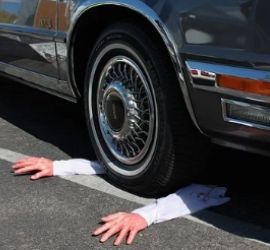Eyewitness Testimony and Reconstructive Memory Flaws
 Eyewitness testimony can provide very compelling legal evidence. But rather than recording experiences flawlessly, memories are susceptible to a variety of errors and biases. Reconstructive memory can result in errors in remembering specific details. Witnesses can even remember whole events that did not actually happen.
Eyewitness testimony can provide very compelling legal evidence. But rather than recording experiences flawlessly, memories are susceptible to a variety of errors and biases. Reconstructive memory can result in errors in remembering specific details. Witnesses can even remember whole events that did not actually happen.
What Is Eyewitness Testimony?
Eyewitness testimony is the result of a person witnessing a crime, or accident, or another legally important event. That person later gets up on the stand and recalls for the court all the details of the event. But, recalling those details involves a more complicated process than might initially be presumed. There are circumstances that happen during the actual crime to facilitate or hamper witnessing. There is also everything that happens from the time the event is over to the later courtroom appearance. The eyewitness may be interviewed by the police and numerous lawyers. The witness may be asked to describe the perpetrator to several different people. The witness may even be required to make an identification of the perpetrator from a lineup or photographs.
Eyewitness testimony is an important area of research in cognitive psychology and human memory. Juries tend to pay close attention to eyewitness testimony and generally find it a reliable source of information. However, research into this area has found that eyewitness testimony can be affected by many psychological factors.
Why Is Eyewitness Testimony an Important Area of Psychological Research?
When an eyewitness stands up in front of the court and describes what happened from her own perspective, this testimony can be extremely compelling—it is hard for those hearing this testimony to take it “with a grain of salt,” or otherwise adjust its power. But to what extent is this necessary?
There is now a wealth of evidence suggesting that eyewitness testimony is probably the most persuasive form of evidence presented in court. This conclusion emerges after research conducted over several decades. But in many cases, the accuracy is questionable and doubtful. There is evidence that mistaken eyewitness evidence can lead to a wrongful conviction. The result can send people to prison for years, even to death row, for crimes they did not commit. Faulty eyewitness testimony has been implicated in at least 75% of DNA exoneration cases—more than any other cause (Garrett, 2011).
In a particularly famous case, a man named Ronald Cotton was identified by a rape victim, Jennifer Thompson, as her rapist. He was found guilty and sentenced to life in prison. After more than 10 years, he was exonerated, and the real rapist identified based on DNA evidence. For details on this case and other individuals whose false convictions were subsequently overturned with DNA evidence, see the Innocence Project website (http://www.innocenceproject.org/).
Kinds of Memory Biases
Memory is susceptible to a wide variety of other biases and errors. People can forget events that happened to them and people they once knew. They can mix up details across time and place. They can even remember whole complex events that never happened at all. Importantly, these errors, once made, can be very hard to unmake. Memory is no less memorable just because it is wrong.
Some small memory errors are common, and you have no doubt experienced them yourself. You set down your glasses and then cannot find them later when you go to look for them. Or, maybe you try to come up with a person’s name but cannot come up with it. You recognize the person and have the sense that the name is right on the tip of your tongue.
Other sorts of memory biases are more complicated and longer lasting. For example, it turns out that our expectations and beliefs about how the world works can have huge influences on our memories. Because many aspects of our everyday lives are full of redundancies, our memory systems take advantage of the recurring patterns by forming and using schemata, or memory templates (Alba & Hasher, 1983; Brewer & Treyens, 1981). Thus, we know to expect that a library will have shelves and tables and librarians, and so we don’t have to spend energy noticing these at the time. The result of this lack of attention, however, is that one is likely to remember schema-consistent information (such as tables), and to remember them in a rather generic way, whether or not they were actually present. (Source: nobaproject.com)
Confidence vs Accuracy – Reconstructive Memory
Surveys show that most jurors place great emphasis on eyewitness testimony when deciding whether a suspect is guilty. But although eyewitness reports are sometimes accurate, jurors should not accept them blindly. Research shows that many factors can bias such reports. For example, jurors tend to give more weight to the testimony of eyewitnesses who report that they are very sure about their identifications. However, most studies indicate that highly confident eyewitnesses are generally only slightly more accurate. Often, they are no more accurate than those who are less confident.
Reconstructive Memory
The blind acceptance of eyewitness accounts may stem from a popular misconception of how memory works. Many people believe that human memory works like a video recorder. The mind records events and then, on cue, plays back an exact replica of them. On the contrary, psychologists have found that memories are reconstructed rather than played back each time we recall them. The act of remembering is more like putting puzzle pieces together than retrieving a video recording.
Memory doesn’t record our experiences like a video camera. It creates stories based on those experiences. The stories are sometimes accurate, sometimes largely fictional, and often a mixture of the two. They can change to suit the situation. Eyewitness testimony is a potent form of evidence for convicting accused criminals. But it is subject to unconscious memory distortions and biases even among the most confident of witnesses. Memory can be remarkably accurate or remarkably inaccurate. Without objective evidence, the two are indistinguishable. Even questioning by a lawyer can alter the witness’s testimony. This is because fragments of the memory may be combined with information provided by the questioner. This ultimately can lead to inaccurately recalling an event or situation.
Reconstructive Memory – Believing Is Seeing.
The first step toward correctly identifying something you’ve seen before is seeing it accurately to begin with. Research over the past few decades has revealed much about how vision works. Visual sensation is the initial process of detecting light and extracting basic image features. However, only a small fraction of what is sensed is actually perceived.
- Attention is the filtering process by which information sensed by the visual system is selected for further processing.
- Perception is the process by which attended visual information is integrated, linked to an environmental cause, made sensible, and categorized. Through the assignment of meaning, utility, value, and emotional valence. It is the things perceived that populate visual experience and memory.
The fidelity and significance of the reported visual experience are necessarily limited by three related factors: uncertainty, bias, and confidence. (This is not unique to vision. These factors influence reports of any sensory experience.) The uncertainty here refers to the probabilistic nature of sensory signal detection in the presence of noise. Vision is plagued by noise from many natural sources, some associated with the structure of the visual environment (e.g., occluding surfaces, glare, shadows), some inherent to the optical and neuronal processes involved (e.g., refractive error or scattering of light in the eye), some reflecting sensory content not relevant to the observer’s goals (e.g., a distracting sign or a loud sound). The presence of such noise leads to uncertainty about what we’re actually looking at, such that any decision we might make or information that we store in memory has a significant likelihood of being wrong. (Source: https://www.pnas.org/)
Reconstructive Memory – Memory is Malleable.
The information perceived by an eyewitness is stored in memory. It is made available for retrieval when called upon to identify a suspect. This type of memory is declarative, in that it consists of consciously accessible content. It involves the things perceived, their meaning, and sequence over time. However, it is mediated by brain systems different from those involved in visual perception. Reconstruction operates with different dynamics, but its products are similarly influenced by uncertainty, bias, and confidence.
Declarative memories are conceptualized as involving three core processes—encoding, storage, and retrieval—which refer, respectively, to the placement of items in memory, maintenance therein, and subsequent access to the stored information (32). These are not passive, static processes that record, retain, and divulge their contents in an informational vacuum, unaffected by outside influences. The contents cannot be treated as a veridical permanent record, like photographs stored in a safe. On the contrary, the fidelity of our memories may be compromised by many factors at all stages of processing, from encoding through storage to the final stages of retrieval (Source: pnas.org)
Eyewitness Testimony – Conclusion
Eyewitness testimony is very powerful and convincing to jurors, even though it is not particularly reliable. Identification errors occur, and these errors can lead to people being falsely accused and even convicted. Likewise, eyewitness memory can be corrupted by leading questions, misinterpretations of events, conversations with co-witnesses, and their own expectations for what should have happened. People can even come to remember a series of events that never occurred.
To protect the public from wrongful convictions based on eyewitness misidentification, it is important that both law enforcement and the courts take notice of recent developments on the issue in the social sciences. The courts must be aware of the malleable nature of human reconstructive memory. This is evident in the lineup practices used by law enforcement. Although they are downstream of the primary problem, the courts have the power and duty to properly instruct jurors. Further, courts have the ability to refuse to admit evidence that does not meet a fundamental level of trustworthiness.
Reconstructive memory and memory bias
Reconstructive memory refers to a class of memory theories that claim that the experience of remembering an event involves processes that make use of partial fragmentary information as well as a set of rules for combining that information into a coherent view of the past event. These theories provide a powerful way of understanding how witnesses remember crimes, how reliable recovered memories of abuse are, and how jurors remember testimony. According to reconstructive theories of memory, ordinary memory is prone to error.
Errors in remembering can be broken down into errors of omission, in which information is left out of a memory report, and errors of commission, in which inaccurate information is added to a memory report. Errors of commission are more typically referred to as false memories or memory illusions. Reconstructive theories of memory generally hold that errors of omission and errors of commission are related to one another. In fact, according to reconstructive theories of memory, errors of commission occur because reconstructive processes are used to fill in gaps in our memory reports. (Source: http://psychology.iresearchnet.com/)



